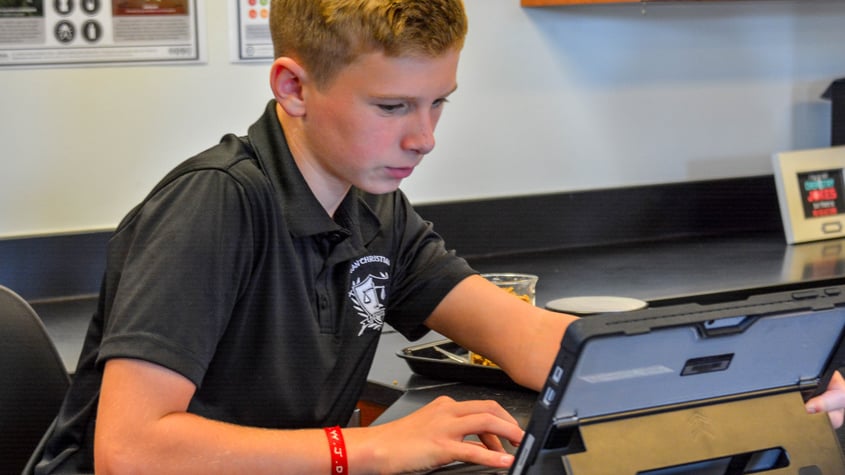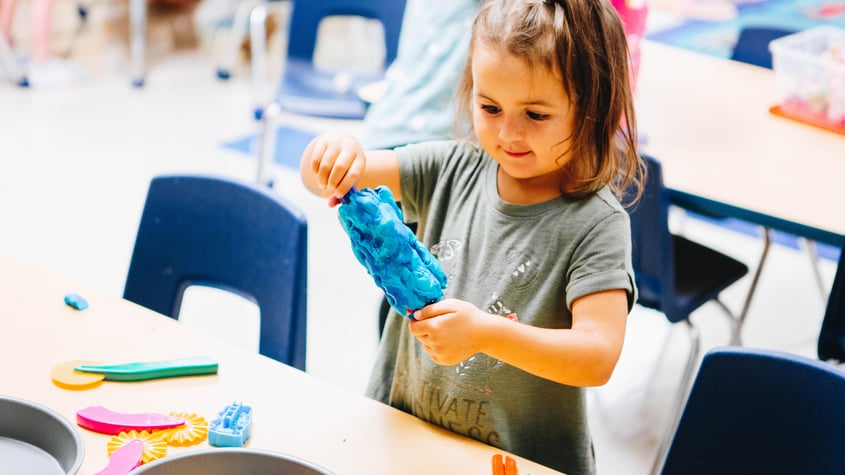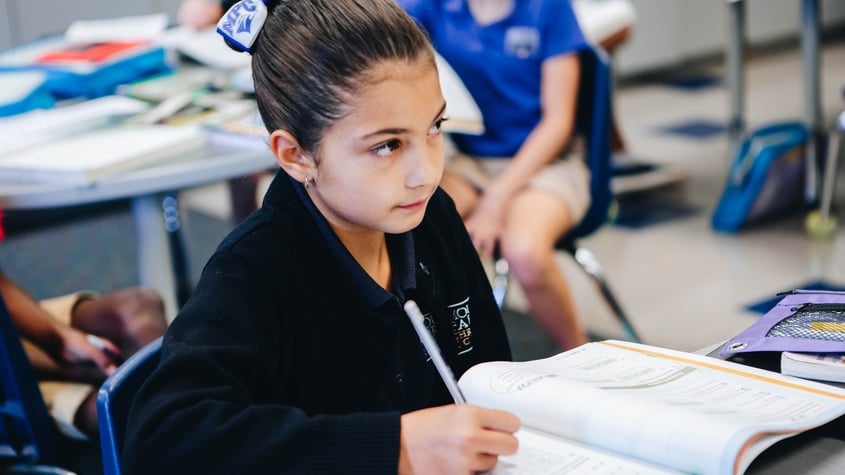
From the Teacher's Desk: The Importance of Play
On March 7, 2012, the face of technology was forever changed with the introduction of the Apple iPad. It’s hard to believe that more than a decade has passed since the invention of the now ubiquitous tablet. While pioneering developments such as the telephone and television were revolutionary, the current pace of technological advances is astounding. Our society is constantly attempting to keep pace and re-establish norms.
The influence of technology has affected all of us, but perhaps none more so than today’s students. Researchers are continuously working to understand the impact of these advances, especially on young children. As tablets and screens continue to grow in popularity, one classic childhood pastime is taking a back seat to technology – play.
SCREENS ARE EVERYWHERE
For most Americans, screens of some sort have been a constant companion in our lives. According to Britannica.com, “In 1927 the American Telephone and Telegraph Company (AT&T) gave a public demonstration of the new [television] technology, and by 1928 the General Electric Company (GE) had begun regular television broadcasts.” Growth took off in the ensuing years, whereby “Television replaced radio as the dominant broadcast medium by the 1950s and took over home entertainment. Approximately 8,000 U.S. households had television sets in 1946; 45.7 million had them by 1960,” reports Elon University. And, by the 1980s, personal computers were making their way into homes across America.
We were already surrounded by televisions, tablets, and smartphones before the landscape of our world faced upheaval a few years ago with the onset of a pandemic. COVID changed everything, from how groceries were purchased, to how and where employees worked, and how school-aged children engaged in learning. In the environment of 2020, technology became more than just a tool of convenience or entertainment. It became the way in which we worked, learned, and, in many cases, communicated with the outside world. Now, more than ever, technology has become a necessity.

BALANCING TECH TIME

Our world has changed, and people of all ages have adjusted. Technology is not evil, but a tool to be used responsibly. And, for all their immersive experience with technology, today’s students are digital natives. God only knows what the future holds and how children’s exposure to technology can impact society for the good. Still, the negative impacts of too much screen time are real and can be rather daunting.
The journal JAMA Pediatrics revealed in a study that, "Since the advent of mobile electronic devices, infants aged between 6 and 18 months are exposed to two to three hours of screen time per day." The research suggests that infant screen use results in issues in the areas of attention and Executive Functioning as children age. In a news report by Rob Lenihan, “The American Academy of Pediatrics recommends that babies younger than 18 months get no screen time at all. For children between 18 and 24 months old, the academy said screen time should be limited to watching educational programming with a caregiver. The academy advised turning off televisions and other devices when not in use and avoid using media as the only way to calm a child.”
Today’s preschoolers and elementary-aged students belong to a generation marked by high technology use and reduced social interaction. This is a group of children whose basic developmental milestones have been adversely affected, specifically in the areas of speech and language development, gross and fine motor development, and the foundational cognitive skills needed to build learning. These unfavorable effects to child development are not only real, but can have a lasting impact if not remediated. However, once known and understood, these effects can be overcome by intentionally incorporating some simple practices.

IMPACT ON SPEECH AND LANGUAGE DEVELOPMENT
Technology makes it possible to be in a space with others, but never talk. Technology talks “at” you, not “with” you, affecting both receptive and expressive language development. Both children’s speech and language are affected by technology overuse. The long-term effects include a lessened vocabulary, an unskilled understanding of relational communication, and, ultimately, a lower emotional intelligence.
There are ways to repair some of these delays with interventions. Providing opportunities for children to explore and question, taking them places that connect multiple senses, and engaging with more storytelling and less story receiving from a screen are all ways to enhance and/or restore speech and language development. Simply put, engage in more dialogue and less screen time.
IMPACT ON MOTOR DEVELOPMENT
Educators of young children have begun to see a generation of children who don’t know how to play, when, in reality, play is child’s “work”. Pediatricians and occupational therapists have noted a significant change in muscle tone and core strength, even in how children walk.
Without taking time to play on the playground – to climb, run, and swing – gross motor development is hindered or halted altogether. The loss in children’s muscle tone and strength also leads to a delay in fine motor skills development later and possibly overall physical unhealthiness.

Much like speech and language, the delays in motor development can be overcome with simple interventions. Children need every opportunity to test the boundaries of their little bodies. They need to climb, ride push and pedal toys, swing, slide, and run, run, run. Children need opportunities to throw, push, pull, and lift.
Even simple things like taking a walk – outside of a stroller – are essential for development. Making available varied types of surfaces children are asked to walk on helps with balance and the development of strong feet and legs. Same activities used to help a baby hold up his or her head and learn to roll over are still essential in the development of a preschool-aged child. Lying on their bellies to look at books is simple but has lasting physical benefits. Simply put, let’s get outdoors.

IMPACT ON COGNITIVE SKILLS
 Although changes and delays in developmental milestones have a correlation to the growing use of technology and screen time, the necessary foundational cognitive skills required to build learning have been affected the most.
Although changes and delays in developmental milestones have a correlation to the growing use of technology and screen time, the necessary foundational cognitive skills required to build learning have been affected the most.
Any type of technology-driven activity, even a “learning game”, is designed to keep a child engaged with the screen for longer and longer periods of time. Technology “thinks” for a child, not the other way around. The game decides what, when, and how the player is to think. Children born into a world where technology is the ruler lose the ability to think creatively. When children aren’t made to use their imaginations, they lose the practice of being bored. This means they do not or cannot think for themselves, which has long-term ramifications, including attention, memory, and eye muscle development.
Physicians have seen a significant rise in children with attention disorders. The correlation between the development of neurons in a child’s brain and technology’s ability to block those connections is significant. Some of those connections help with short- and long-term memory – skills needed for learning throughout life.

One of the most recently studied effects of the over-reliance on technology has been the decline of eye muscle development in children. Screen games are created such that the user’s eyes move quickly from place to place but are rarely made to stay focused in one place for long. Yet, God designed the human eyes to work together and focus. When this doesn’t happen early on for children, they lack the eye muscle development needed to do things like tracking when learning to read. Clinicians state this lack of eye development is leading to the misdiagnosis of attention disorders. Eyes that are tired cannot focus, and, therefore, children find themselves focusing elsewhere, becoming distracted and off task.
Following a simple “one to two” rule – every one minute of screen time is offset with a minimum of two minutes of a multi-sensory activity or experience – is an easy way to keep track of and reduce technology’s hold on the minds of young learners.

The reality of our modern world is that technology is not going anywhere. It has its place and purpose. Yet, parents and educators must be aware of the implications of its overuse so as to avoid letting technology take the place of other beneficial experiences.
Simply put, go back to the basics. Talk, run, explore, ask questions, and use all the body’s senses at once. Most importantly, children should be given every opportunity to do their job – play.
Penny Harrison is the head of preschool for Mount Paran Christian School, having previously served in the classroom for 14 years. She served in full-time ministry for 18 years, including as a children's pastor.
To read more about how technology affects older children, including “screenagers”, click here. We also invite you to learn more about the preschool at Mount Paran Christian School by clicking here.
- church preschool
- PreK
- prek4
- christian school
- christ-centered
- Bible Study
- mount paran christian school
- preschool
- Christian Life
- Discipleship
- early childhood education
- faith
- elementary school
- weekday preschool
- pre-k
- Pre-Kindergarten
- Advanced Preschool
- kindergarten readiness
- christian values
- biblical principles
- parent resources
- christian education
- why christian education
- why christian school
- defend faith
- preschool STEM
- christian values in today's culture
- preschools in kennesaw
- family values
- family time
- private schools in atlanta
- 21st century preschool
- higher preschool achievement
- Christian Teachers
- preschool parenting
- raising christian kids
- best of Cobb private school
- best private school Cobb county
- Best Preschool Cobb County
- Best Preschool Marietta
- best christian school georgia
- christian education Bible
- raising elementary school children
- parenting elementary kids
- choosing a private school
- best of Cobb best preschool
- best preschool west Cobb
- Best preschool in marietta
- best preschool in Kennesaw
- best christian school Kennesaw
- Bible Teaching Series school
- Christians and politics
- best of Cobb preschool
- best preschool kennesaw
- best preschool in cobb
- faithful parenting
- advice for parents of young children
- orton-gillingham
- complete reading series
- how to choose a preschool
- preschool teacher training
- nurturing the whole child
- preschoolers development
- what makes a preschool great
- choosing a preschool
- preschools near Marietta

WingTips
Welcome to WingTips, a Mount Paran Christian School Blog. The MPCS Blog features many independent school contributors and thought-leaders.
Subscribe Here!
Recent Posts
Learn More About MPCS
Recommended Series
PRIVATE SCHOOL PRIMER:
- How School Choice Programs Increase Educational Opportunities for Families
- 5 Tips for Making the Middle to High School Transition
- What Families Should Expect
- 2 Most Important Things to Consider When Choosing a Preschool
- 4 Benefits of Choosing a K-12 School for Life
- 3 Reasons Why I Believe in Christian Schools
- 7 Tips for Affording a Private School Education
- 4 Reasons We Chose Mount Paran Christian School
- How to Choose the Best Private School for Your Family
- 4 Methods to Meet Every Learner Where They Are
PARENTEd. TALKS:
- Helping Students Boost Their Brain Capacity for Success
- Teaching Children Fiscal Responsibility
- Tips for Parents to Help Teens Avoid Drugs and Alcohol
- Excelling in the Midst of Adversity
- 3 Tips for Navigating the Hidden Dangers of Social Media
- The Blessing of a B Minus
- Real Talk for Moms
COLLEGE SERIES:
- Finding the Right Fit - An Individualized Approach to College Counseling
- ParentEd.: Here’s What You Need to Know About College Admissions
- To Save or Not to Save: 529 Plans are the Question
- College Admissions: A Marathon, Not a Sprint
FROM THE TEACHER’S DESK:
- The Importance of Play
- What Families Should Expect
- Play is Learning Through the Arts
- 4 Tips to Capture the Minds of Your Students
CHRISTIAN LIFE:
- What is a Covenant School?
- Seeing Through a New Lens: A Biblical Worldview
- Faith and Intellect as One
- Philosophy of Belonging: 4 Tips for Fostering a Diverse Culture
- Innovation in Education: Teaching Cultural Awareness
- A Call to Brotherhood: Martin Luther King Jr.’s Wisdom for Today
- CommUNITY: How Do We Love One Another?
- Campaign for CommUNITY
- How to Raise Empathetic Children in Today’s Culture
- Imageo Dei: Why Diversity Matters
- Praying for Their Future
Providing academic excellence in a Christ-centered environment, Mount Paran Christian School unites with home and church to prepare servant-leaders to honor God, love others, and walk in Truth.



